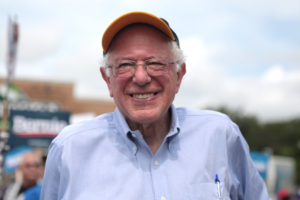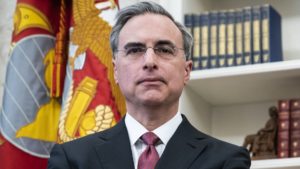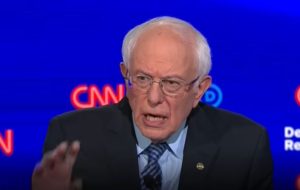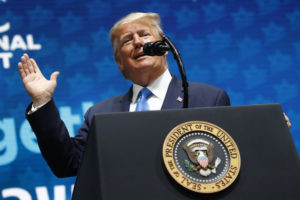Lessons From the Democratic Battle of Nevada: In the Campaign Home Stretch, Organize, Don’t Agitate
What really happened in Vegas? Showing how one group unintentionally undermined Bernie Sanders' cause, an eyewitness to the tense state convention refutes claims of violence and warns supporters to play smart and know the rules. Nevada Democratic Party Chairwoman Roberta Lange abruptly concluded the state's nominating convention. (Kaitlin Crowley)
1
2
3
4
Nevada Democratic Party Chairwoman Roberta Lange abruptly concluded the state's nominating convention. (Kaitlin Crowley)
1
2
3
4
But the language of the report was misleading. It’s true that the Clinton campaign presented the credentials committee with a list of 64 Bernie delegates they took issue with. As the credentials committee worked to verify those 64, they discovered that as many as 50 of them hadn’t tried to register for their credentials at the convention, and so might not even be present on site. Six of the 64 were allowed to participate in the convention and were included in the final count. Even if the remaining eight delegates listed on the minority report had been admitted to the convention, the final delegate count would have been 1,695 Clinton, 1,670 Sanders. We still would have been 25 shy.
Jumping forward again, we next had another breakout session to elect national delegates by write-in ballots. This lasted more than two hours, and delegates began to leave after casting their votes. This was cutting out early, since we still had unfinished business, but it was nearing 9 p.m., when the convention was scheduled to conclude. During this time many Sanders delegates received a text message urging them to stay until the end of the convention, cautioning that “we lose delegates” if people leave. Subsequently, most of Sanders’ camp remained. It was unclear if the messages came from the official campaign.
By the time the convention reconvened to vote on the party platform (the last voice vote we would take) a majority of Clinton delegates had left. The platform was easily voted down. It contained an amendment in the “Elections and Government” section that some Sanders supporters felt contained vague language about future reform of superdelegates. In keeping with convention rules, we voted to pass or strike down each section of the platform individually. When we got to the section in question, the “nays” carried it and we dropped the section from the platform in its entirety. Members of the “Team Bernie” group were instrumental in leading the charge.
This was not a proud moment for Sanders supporters, however, and it hasn’t been widely publicized. The Elections and Government section contained crucial positions in favor of campaign finance reform, overturning Citizens United, making voting days national holidays, opposing voter ID laws and many other progressive policies that sit at the center of Sanders’ agenda. Many fellow Sanders delegates were surprised that we didn’t have the chance to go through the section line by line, but there’s no provision for that in the rules of the convention.
After this, Jesse Sbaih, a Democratic candidate for the U.S. House of Representatives, motioned for a recount. You probably heard about this. What you may not know is that absolutely nowhere do the rules of the convention—nor any of the documents that supplement it—give grounds for a head count at this point in the process. The final delegate count we received at 6 p.m. established the “Strength of the Convention,” which determined the apportionment of the remaining 12 national delegate seats that were up for grabs. According to the rules, once this count was finalized by the credential committee and those delegates were assigned to each candidate, there was no going back. If the previously agreed-upon rules are to be respected, then the 10 p.m. motion for a recount, especially the idea that we could now take a head count when our initial delegate totals were essentially balloted, was a fantasy.
It was also morally dubious. One of the reasons I back Bernie Sanders and am such an active volunteer in this campaign is his integrity. I don’t think Sanders would endorse a count in hour 11, one hour later than the convention had been slated to adjourn and after most of the other side had gone home. Voting is not a war of attrition. It’s a right. We would have been incensed if the Clinton delegation called for a head count when Sanders’ delegates weren’t present. And in fact, that’s exactly what many accounts of the convention I’ve read allege—that a vote was taken in the morning while Sanders delegates were outside the convention hall. As I explained earlier, that’s false. It is true, however, that a contingency of Sanders activists lobbied for a warm body count after most of the Clinton camp had left. I didn’t endorse this recount at the time and I don’t endorse it now.
Unsurprisingly, we didn’t get one.
What we did get was Lange’s most infamous act of misconduct that day. I was sitting in the front row of the Sanders delegation and had my phone out when Lange marched briskly to the podium. She made a motion to accept the list of the 12 remaining nominees for national delegate positions that had been submitted by each campaign, passed the motion herself without putting it to a voice vote, and adjourned the convention with a drop of her gavel before fleeing the stage.
Not only were delegates expecting a recount, they were also anticipating voting on our picks for the last rounds of national delegates. Candidates for these positions had spent the day campaigning for the spots, and many had invested in buttons, shirts or pamphlets that they’d distributed to other conventiongoers. If you saw video of this moment, you were almost definitely watching the footage I shot and immediately posted to social media. After Lange runs off the stage, I pan the camera to show the shock and dismay of 1,000-plus Sanders delegates. Without discussion, the chairwoman had just denied us an opportunity to cast our last ballots and closed the convention without putting it to a voice vote.
Shortly thereafter, security guards entered and delegates were forced to leave the convention hall. More than 12 hours after the convention was called to order, we finally streamed out into the main body of the Paris Las Vegas Hotel & Resort, which hosted the convention. Most attendees came away convinced that the Nevada State Democratic Party and its officials had robbed Sanders of a narrow victory.
Your support matters…
SUPPORT TRUTHDIG
Independent journalism is under threat and overshadowed by heavily funded mainstream media.
You can help level the playing field. Become a member.
Your tax-deductible contribution keeps us digging beneath the headlines to give you thought-provoking, investigative reporting and analysis that unearths what's really happening- without compromise.
Give today to support our courageous, independent journalists.






You need to be a supporter to comment.
There are currently no responses to this article.
Be the first to respond.